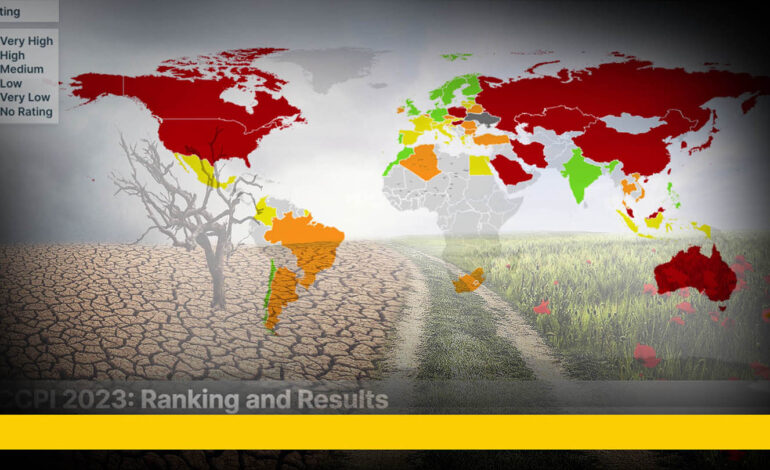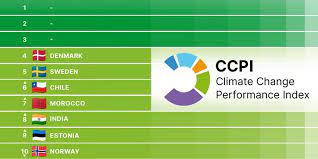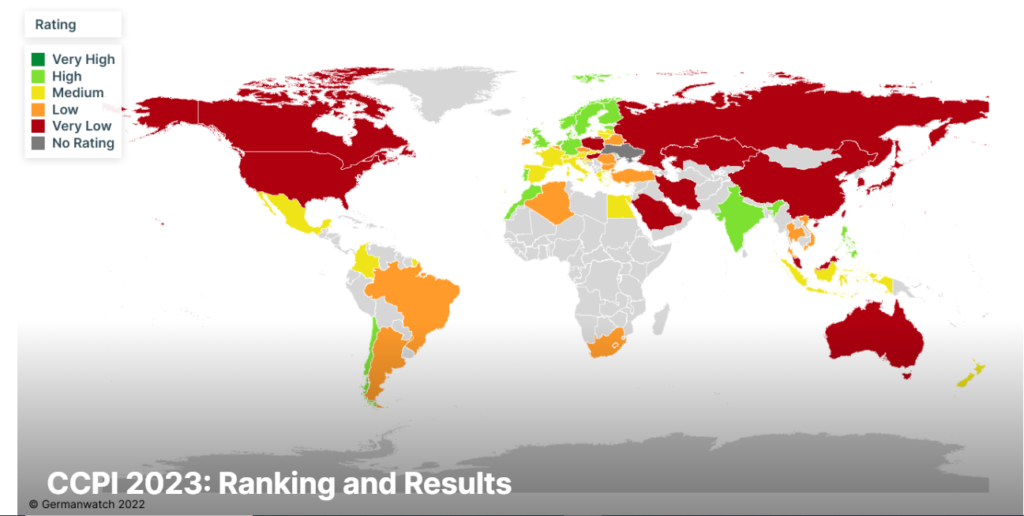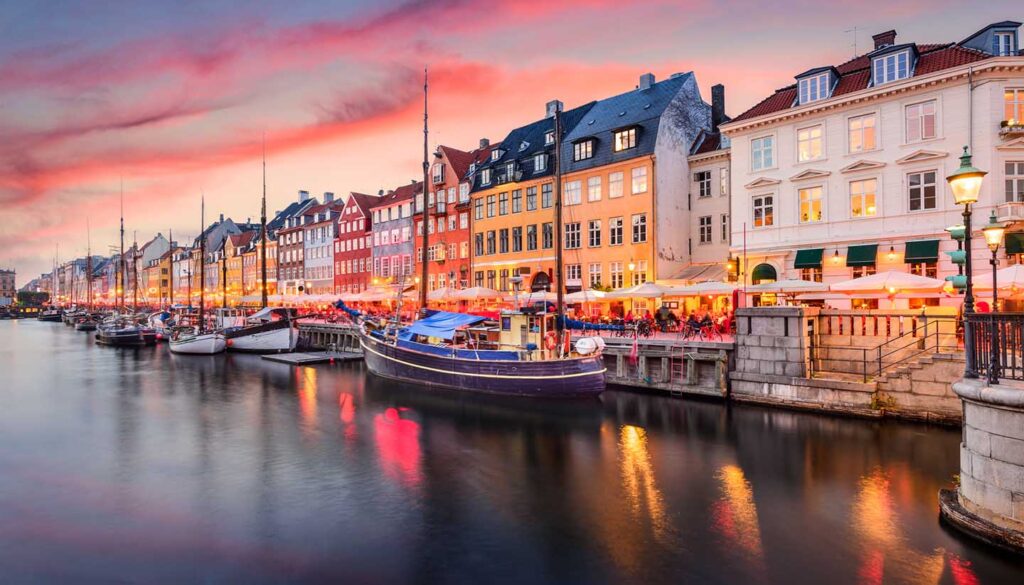Climate Change Action: Lessons from Denmark

Denmark, Sweden, and Chile are the three countries that adopt the best climate change mitigation measures in the world, according to the Climate Change Performance Index (CCPI) 2023. Morocco, India, Estonia, and Norway come next in line. Interestingly, the top 3 slots remain vacant in this list as “no country was strong enough in all index categories to achieve an overall very high rating”. The current top performer Denmark is in the 4th position.
This rating is based on four aspects related to climate change: 1) how much greenhouse gas emission a country emits; 2) how much renewable energy a country produces; 3) what the total energy use of a country is, and 4) what climate policies does a country have.
Denmark’s example is remarkable. In a few decades, it has halved the quantum of its greenhouse gas emissions without compromising on economic growth. Its economy doubled in size during this period. It has also declared that it would cut emissions further by 70% by 2023 from the 1990 level.
In 2020, Denmark pledged to stop exploring oil and gas by 2050. What the country did to achieve this goal was quite innovative. It reinvested the funds kept aside for oil and gas exploration to retrain its citizens as skilled workers associated with green technologies.

The Global Leader in Renewables
Denmark leads the world in renewable energy production. It’s per capita wind energy production exceeds that of any other country in the world. Fifty per cent of its energy needs are met with solar and wind power. A third of global wind energy is produced by Danish companies, which makes it possible for Denmark to export clean energy and profit from it.
Denmark has Scandinavia’s biggest wind farm – Kreiger’s Flak – which powers about 6 lakh households. It is also creating an offshore artificial island named Lynetteholm to house a wind farm. In 2021, the Danish parliament approved the plan for the construction of this island, which will protect the port of Copenhagen, the capital city, from rising sea levels and will also provide housing to 35000 people. This island is designed like a cape that will act as a “storm-absorbing peninsula”. The work on the island began in 2022. However, environmental concerns are being raised about this project on the grounds that generally all mega projects end up affecting the area that they plan to protect and serve.
Bioenergy: The Simple Solution to a Complex Problem
The country literally runs on bioenergy, which fulfils two-thirds of its needs. It is the energy stored in organic material- biomass.
Basically, biomass refers to manure, animal fats, and straw. Denmark has a huge agriculture sector. It is the waste from this sector that becomes the raw material for bioenergy production. Biogas and liquid biofuels are produced out of them. Many Danish power plants have abandoned fossil fuels and replaced them with wood pellets, wood chips, and straws.

The energy produced from biomass is used to heat up households in districts using a network of pipes carrying hot water. Bioenergy is used for electricity generation and transportation as well.
Is bioenergy emission-free? The answer is yes, to a large extent. Demark’s bioenergy production consists of the following energy sources:
- Combined Heat and Power (CHP) plants for electricity and heat generation
- Biogas to meet fuel needs and replace natural gas
- Gasification (heating of biomass using limited oxygen supply) to produce inflammable gases that can be either combusted or upgraded into transportation fuel etc.
- Liquid biofuels such as biodiesel and bioethanol produced by fermenting and distilling biomass and plant-based oils.
The government gives financial support such as feed-in tariffs and feed-in premiums, and tax exemptions to bioenergy producers. They are collaborating with other countries to develop green energy research and technologies.
Taxing Corporates
In 2022, Denmark’s parliament approved a corporate carbon tax which is the highest in any European country. As per this new tax regime, the country will be charging corporate companies a tax of 1125 Danish crowns ($159) per tonne of carbon emission by 2030. This is a bold step given the corporate group’s clout with governments.
A working paper published by the International Monetary Fund in 2020 lauded the climate mitigation policy of Denmark as “a prototype for other countries”. However, expectedly, the paper warns the country not to impose a high tax burden on corporate companies and suggests that a household carbon tax could supplement the carbon taxing goals.
A Nation on Two Wheels
Danish people are world-renowned for using bicycles extensively for their local travel. It is literally a nation on two wheels as it is often called. One of its major tourist attractions is its cycling trails.
Denmark is also the first country to announce that it will provide “loss and damage” climate funding to the less developed countries, an obligation that other developed countries try to evade and defer.
The Danish Council on Climate Change is entrusted with the task of monitoring the climate policies of the country and ensuring that its climate change mitigation targets are met. Recently the Council has observed that the policies are not sufficient to meet the targets. At this pace of formulating policies and implementing them, Denmark is going to achieve only 54% reduction in emissions instead of the target of 70%, said the Council in its first annual report that came out in 2021. It is obvious that even a country as proactive as Denmark is struggling to meet its climate change mitigation targets. There is still a long long way to go for other countries.

This is what Denmark’s Minister for Climate, Energy, and Utilities, Dan Jørgensen said during his visit to the Yale School of the Environment, New Haven, in September 2021: “We want to show the world that you can have a decarbonised economy that is wealthy and provides its people with a high quality of life.”
The Politics of Climate Change
Danish political parties have climate spokespersons. Climate change was a hot campaign issue in the 2019 Danish general elections. The Social Democrats along with their allies won the election promising, among other things, a 70% target for emission reduction.
A Roskilde University study found that climate change was among the topmost election topics in 2019 in Denmark. Why? Denmark is witnessing a rising sea level and a high frequency of storms due to climate change. The Intergovernmental Panel on Climate Change has warned in its reports that Copenhagen will be one of the worst-affected cities by the rise in sea levels. Many parts of the city are already on the verge of inundation.
The Social Democrats came to power in June 2019 and in December of the same year, a new and path-breaking climate law was enacted. BBC reported that this law has made climate change almost “illegal” in Denmark. 90% of the parliament members voted for the law.
According to this law, it is mandatory for the government to go before the parliament every year with its climate change policy and get its approval. The government will have to step down if it cannot win a majority in the voting on its policy.
The law also puts in place a strong monitoring system to track the progress of the government’s climate promises. It also requires the government to set new climate goals every 5 years. It makes legally binding the fulfilment of international climate agreements.
The Danish government has formed 13 climate partnerships in different sectors to reduce emissions by the industries belonging to these sectors. There is a continuing dialogue with the private sector companies on how they can cut emissions and come up with innovative suggestions and plans.
There is an ongoing people’s movement in Denmark demanding that climate change mitigation be added to its Constitution.
Samsø: An Island of Hope
In all these government efforts, what is the level of public agency and participation? How much of the efforts are in the hands of corporate companies? The answer can be found in the example of the island of Samsø in Denmark. It is the first renewable energy island in the world. It is 100% dependent on renewable energy and has got rid of all fossil fuel use, which means that the energy transition is complete and the island is carbon negative. The entire investment in renewable comes from local individuals and companies. As early as 1997, Samsø ventured into its challenging climate mitigation journey; wind, solar, and bioenergy meet the power requirement of the entire island now. It is a strong foundation of community initiative that drives the Samsø model.
While the country supports its big companies to enter and thrive in the renewable energy sector, there is also an equal effort to anchor climate mitigation action in the local community. Obviously, the world can learn a few things from Denmark. For India, the big takeaway is how it can build its climate initiatives on the basis of its rich biomass reserves, and abundant sunlight and wind resources.
Subscribe to our channels on YouTube & WhatsApp












Very informative article…as rightly said, we have abundance resources which need to be tapped prudently
This is an important article to be read widely, congratulations to Deepa